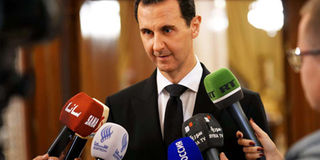Syria rivals accused of using chemical weapons in civil war

Syrian President Bashar al-Assad. His regime has been accused on numerous occasions of using chemical weapons. PHOTO | SANA | HO | AFP
What you need to know:
A US intelligence report says with "high confidence" that Syria's government carried out the attacks. It says 1,429 people were killed, including 426 children.
A joint commission of the United Nations and the OPCW in August 2016 finds that helicopters from regime-controlled air bases dropped chlorine barrel bombs on two villages in the northwestern province of Idlib in 2014 and 2015.
The commission also accuses the Islamic State jihadist group of using mustard gas in August 2015 in the rebel stronghold of Marea in the northern province of Aleppo.
BEIRUT
Since the start of the conflict in Syria in 2011, belligerents — in particular the regime of President Bashar al-Assad — have been accused on numerous occasions of using chemical weapons.
The Organisation for the Prohibition of Chemical Weapons (OPCW) says it has probed 70 gas attacks in Syria since 2014, out of 370 reported incidents.
In August 2013 regime forces carry out attacks in Eastern Ghouta and Moadamiyet al-Sham, rebel-held areas outside Damascus.
The opposition accuses the regime of a large-scale toxic gas attack. The government — which acknowledged in 2012 that it had chemical weapons — denies the allegations.
A US intelligence report says with "high confidence" that Syria's government carried out the attacks. It says 1,429 people were killed, including 426 children.
SARIN GAS
Despite insisting the use of chemical weapons was a red line, President Barack Obama stops short of striking Syria in response.
The US instead opts for diplomacy and agrees a deal with Russia that is supposed to see the regime's chemical weapon stockpiles destroyed.
In mid-September a UN report says there is clear evidence sarin gas was used.
A joint commission of the United Nations and the OPCW in August 2016 finds that helicopters from regime-controlled air bases dropped chlorine barrel bombs on two villages in the northwestern province of Idlib in 2014 and 2015.
MUSTARD GAS
The commission also accuses the Islamic State jihadist group of using mustard gas in August 2015 in the rebel stronghold of Marea in the northern province of Aleppo.
In October, the commission says the Syrian army carried out a chlorine attack at Qmenas in Idlib province in March 2015.
Warplanes strike the rebel-held town of Khan Sheikhun in Idlib on April 4, 2017, with medical sources reporting patients suffering from symptoms consistent with a chemical attack.
The UN puts the death toll at 83, while the the Syrian Observatory for Human Rights monitor says it reached 87.
MISSILES
In retaliation US President Donald Trump unleashes strikes by Tomahawk missiles against the regime's Shayrat airbase overnight April 6-7.
The UN and OPCW investigators confirm that sarin gas was used and that the Damascus regime is responsible. The regime denies.
On January 22, 2018, at least 21 people, including children, suffer breathing difficulties in a suspected regime chemical attack in a besieged rebel enclave near Damascus, the Britain-based Observatory says.
A similar attack had targeted the outskirts of the same city, Douma, in the opposition-held Eastern Ghouta region on January 13, it says.
SUFFOCATION
On February 4, 11 people are treated for "suffocation" amid a "foul smell" after regime air strikes on the northwestern town of Saraqeb, the Observatory says.
It quotes residents and medical sources as saying "toxic gas" was used in the attack.
On February 25 a child dies and at least 13 other people suffer breathing difficulties after a suspected chemical attack on the besieged Syrian rebel enclave of Eastern Ghouta, with a medic describing "chlorine odour."
On March 7, the Observatory says that at least 60 people have suffered breathing difficulties in two areas of Eastern Ghouta after regime air strikes.





